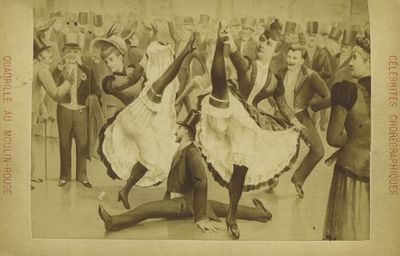Can-can

The Can-Can (also spelled cancan and Can Can) is regarded today primarily as a music hall dance, performed by a chorus line of female dancers who wear costumes with long skirts, petticoats, and black stockings, harking back to the fashions of the 1890s. The main features of the dance are the lifting up and manipulation of the skirts, with high kicking and suggestive, provocative body movements.
The "Galop" from Jacques Offenbach's Orpheus in the Underworld is the tune most associated with the can-can.
Etymology
The name can-can may be derived from the French for tittle-tattle or scandal. However, the dance was also referred to as the coin-coin and this may have become corrupted into can-can. In its early days, the dance was also called the chahut (French for noise or uproar).
Origins
The cancan first appeared in the working-class ballrooms of Montparnasse in Paris in around 1830. It was a more lively version of the galop, a dance in quick 2/4 time, which often featured as the final figure in the quadrille. The cancan was, therefore, originally a dance for couples, who indulged in high kicks and other gestures with arms and legs. It is thought that they were influenced by the antics of a popular entertainer of the 1820s, Charles Mazurier, who was well known for his acrobatic performances, which included the grand écart or jump splits-later a popular feature of the cancan. At this time, and throughout most of the 19th century in France, the dance was also known as the chahut. Both words are French, cancan meaning "tittle-tattle" or "scandal", hence a scandalous dance, while chahut meant "noise" or "uproar".
As performers of the cancan became more skilled and adventurous, it gradually developed a parallel existence as entertainment alongside the participatory form. A few men were cancan stars in the 1840s to 1860s, but women performers were much more widely known. They were mostly middle-ranking courtesans, and only semiprofessional entertainers-unlike the dancers of the 1890s, such as La Goulue and Jane Avril, who were highly paid for their appearances at the Moulin Rouge and elsewhere. These individuals developed the various cancan moves that were later incorporated by the choreographer Pierre Sandrini in the spectacular "French Cancan", which he devised at the Moulin Rouge in the 1920s and presented at his own Bal Tabarin from 1928.
Performance
The cancan is danced in 2/4 time and is now usually performed on stage in chorus-line style. In France in the 19th century, the cancan remained a dance for individual entertainers, who performed on a dance floor. In Britain, the USA and elsewhere, the cancan achieved popularity in music halls, where it was danced by groups of women in choreographed routines. This style was imported into France in the 1920s for the benefit of tourists, and the French Cancan was born - a highly choreographed routine lasting ten minutes or more, with the opportunity for individuals to display their "specialties". The main moves are the high kick (or battement), the rond de jambe (quick rotary movement of the lower leg with knee raised and skirt held up), the port d'armes (turning on one leg, while grasping the other leg by the ankle and holding it almost vertical), the cartwheel and the grand écart (the flying or jump splits). Additionally, performance practice of the can-can almost always includes the dancers screaming, yelling, cat-calling and trilling while dancing.
In art
Many composers have written music for the cancan. The most famous music is French composer Jacques Offenbach's galop infernal in Orpheus in the Underworld (1858). Other examples occur in Franz Lehár's The Merry Widow (1905) and Cole Porter's musical play Can-Can (1954) which in turn formed the basis for the 1960 musical film Can-Can starring Frank Sinatra and Shirley MacLaine.
The cancan has often appeared in the ballet, most notably Léonide Massine's La Boutique Fantasque (1919) and Gaîté Parisienne, as well as The Merry Widow ballet. A particularly fine example can be seen at the climax of Jean Renoir's 1954 film French Cancan.
French painter Henri de Toulouse-Lautrec produced several paintings and a large number of posters of cancan dancers. Other painters to have treated the cancan as a subject include Georges Seurat, Georges Rouault, and Pablo Picasso.
References
Price, David. Cancan! London: Cygnus Arts; New Jersey: Fairleigh Dickinson University Press, 1998. BuyBook|0838638201}}
Chat rooms • What links here • Copyright info • Contact information • Category:Root